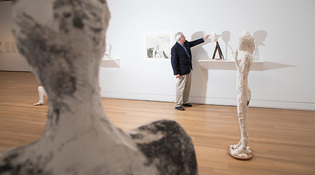 loading
loading
featuresThe farewell tourArt gallery director Jock Reynolds will step down in July. We asked for a last hurrah.  Mark OstowJock Reynolds, surrounded by plaster figures sculpted by his teacher Manuel Neri, points to a detail on Neri’s Male Head No. 1 (1969). The Neri exhibit on the human figure will be up through January 27, 2019. View full imageThere are more than 4,000 works on display at any given time in the Yale University Art Gallery. After nearly 20 years as director of the Gallery, Jock Reynolds knows more than a little about a lot of them. So when it was announced that Reynolds will step down in June, we asked if he would take us—and you, the readers—on a private tour. We met up with Reynolds on a Monday, when the Gallery is closed to the public but nonetheless a hub of activity. Charged with showing us some of his favorite pieces, Reynolds led us through the building, stopping frequently to greet employees, consult on installation questions, or make note of an error in a wall panel. Reynolds, who came to the Gallery in 1998 after directing the art gallery at Phillips Andover Academy, will leave a remarkable legacy at Yale. During his tenure, the Gallery pulled off a $135 million renovation and expansion: its 1928 building and 1953 addition by Louis Kahn were restored, and the Gallery expanded into what had been the art history department in Street Hall. Reynolds also established departments for African and Indo-Pacific art, with the help of some major bequests and acquisitions in those areas. In teaching classrooms on site and in the Wurtele Study Center on the West Campus, the Gallery has made more of its works available to students and scholars. And all this while keeping admission to the Gallery free to the university and the community. Reynolds, who trained as a sculptor, says he’ll return now to making art. His work with his wife, Suzanne Hellmuth, has involved installations, often informed by historical images, documents, and artifacts—not all that different in some ways from the work of a museum director. But his path of the last few decades is still surprising to him. “If you had told me 30 years ago that I’d be running two museums in the next 30 years of my life, I would’ve told you you were out of your mind,” he says. “So you never know.” —The Editors
|
|